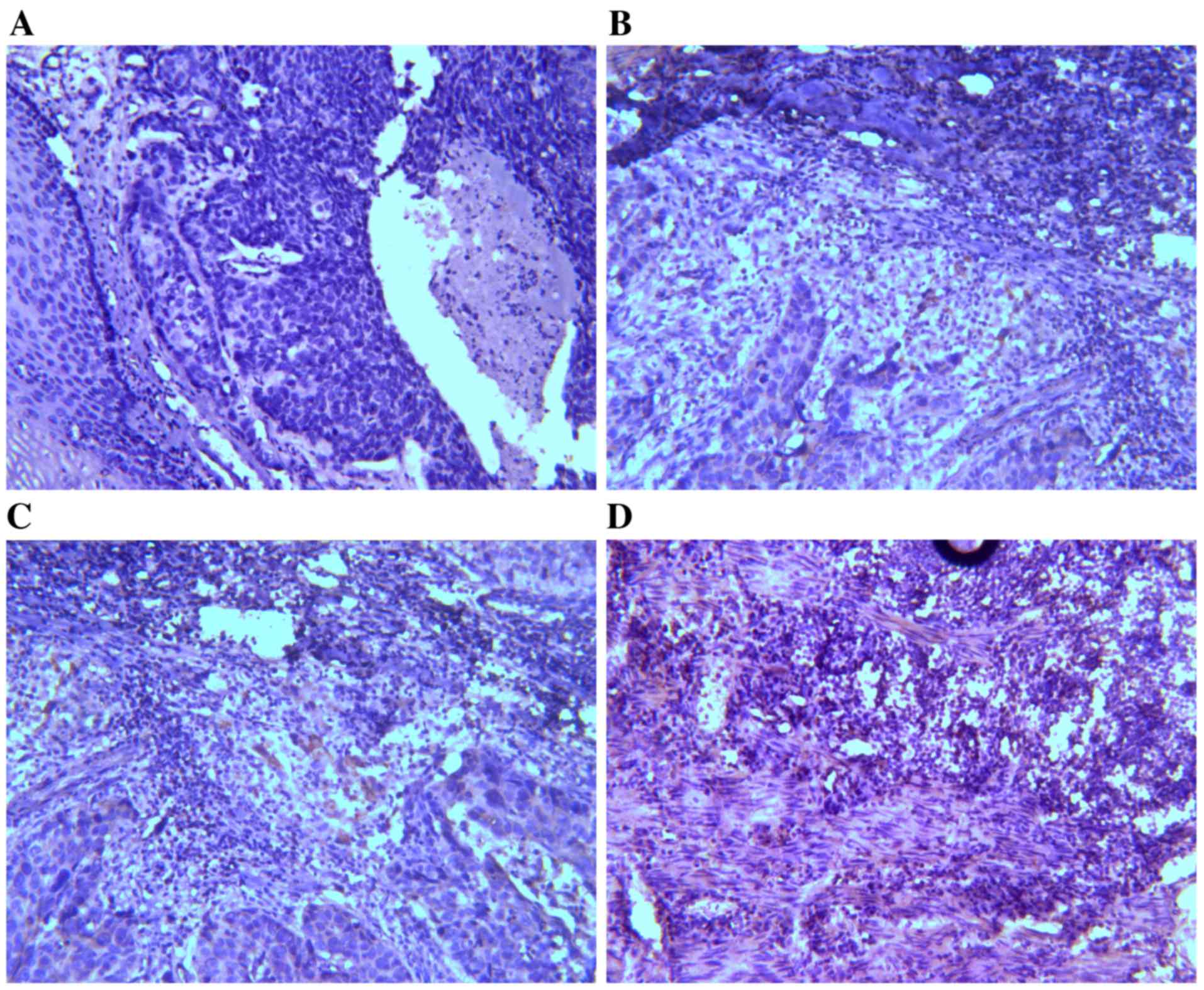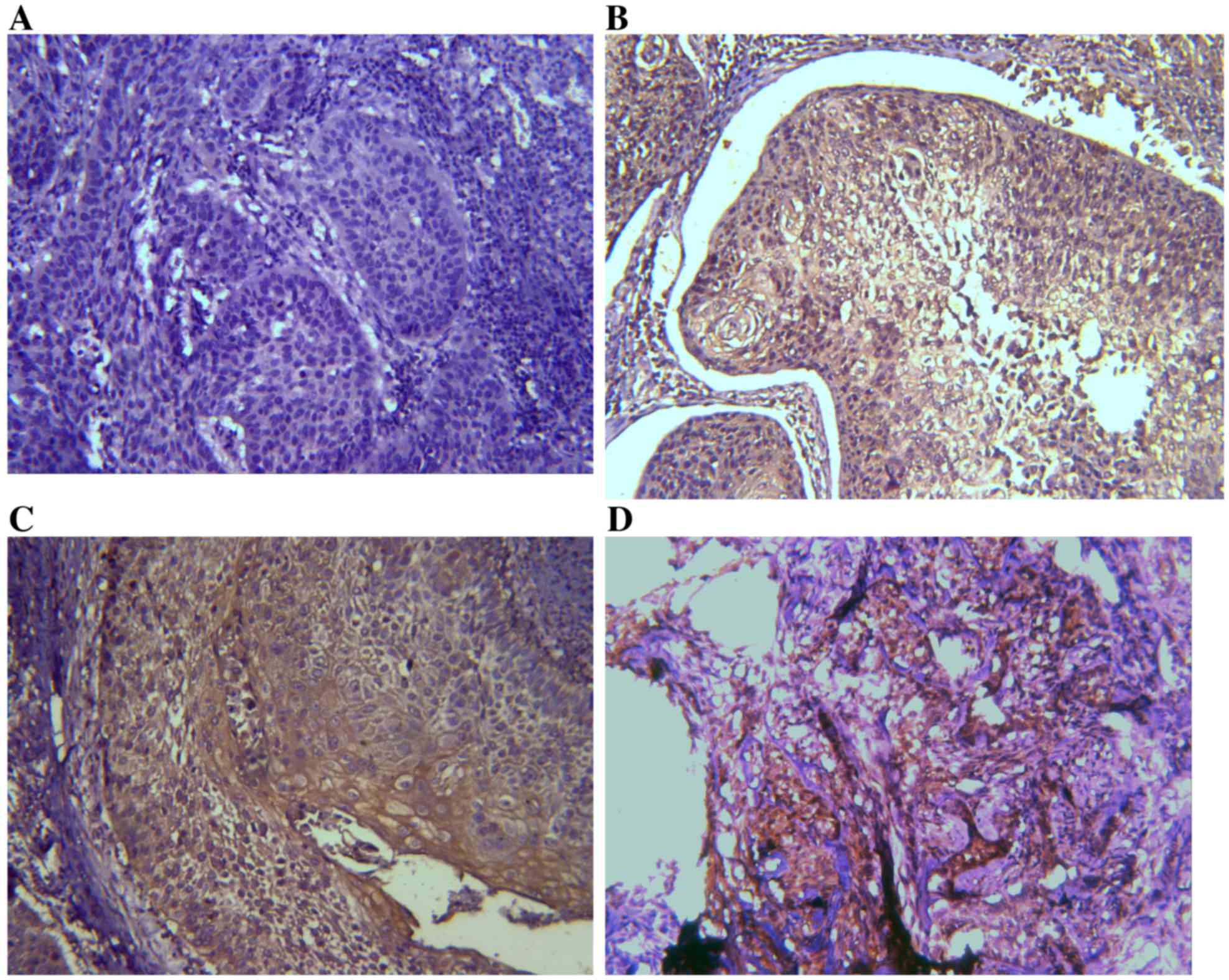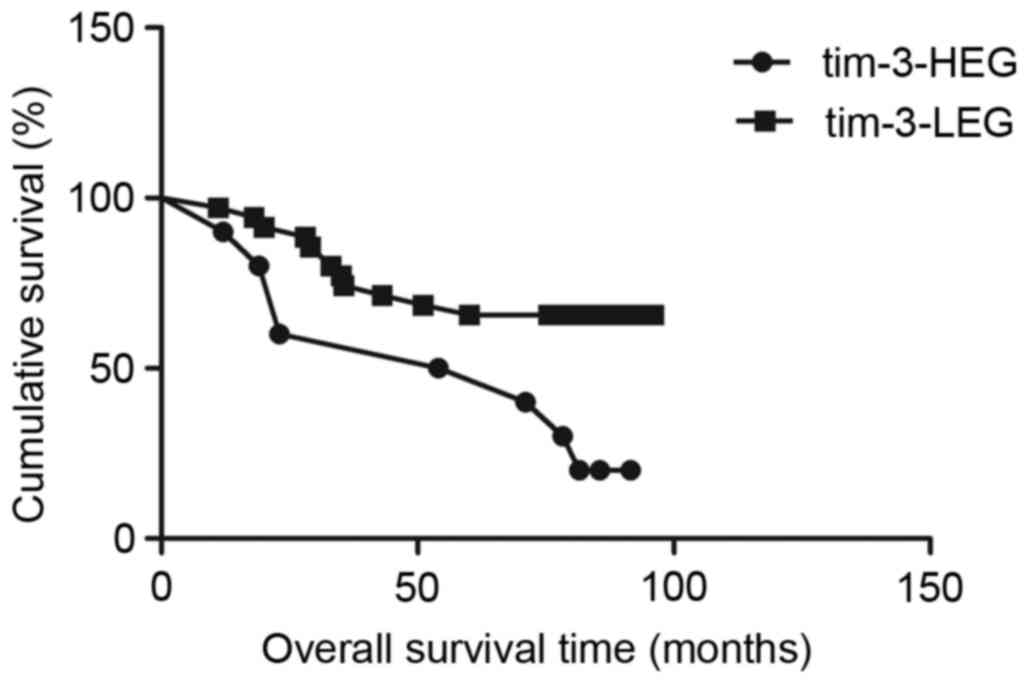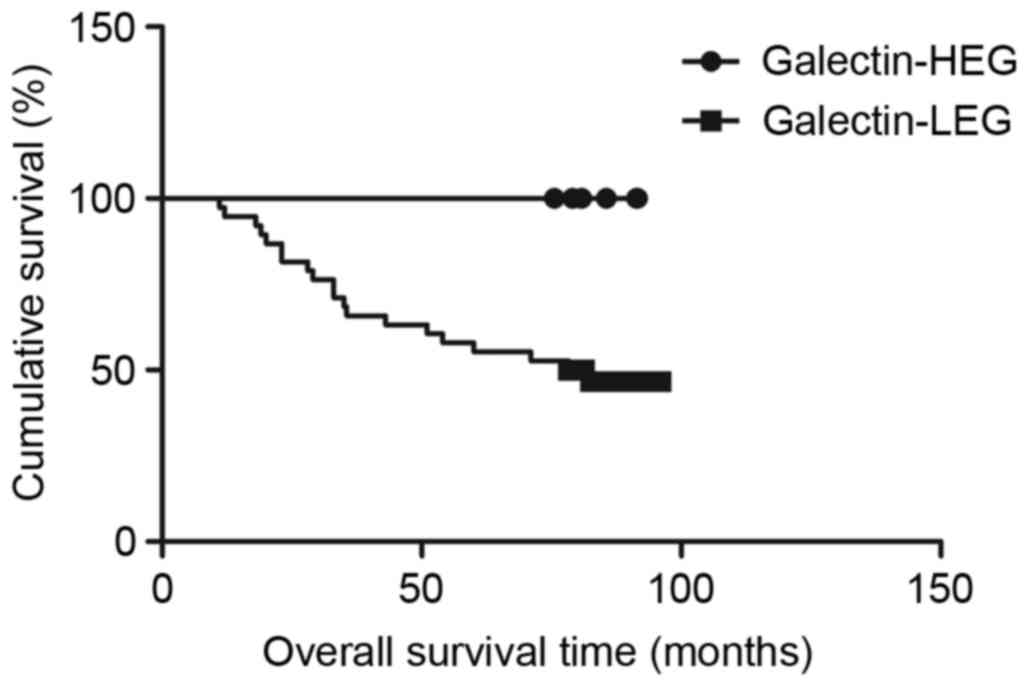|
1
|
Domper Arnal MJ, Ferrández Arenas Á and
Lanas Arbeloa Á: Esophageal cancer: Risk factors, screening and
endoscopic treatment in Western and Eastern countries. World J
Gastroenterol. 21:7933–7943. 2015. View Article : Google Scholar : PubMed/NCBI
|
|
2
|
Chen W, Zheng R, Baade PD, Zhang S, Zeng
H, Bray F, Jemal A, Yu XQ and He J: Cancer statistics in China,
2015. CA Cancer J Clin. 66:115–132. 2016. View Article : Google Scholar : PubMed/NCBI
|
|
3
|
Napier KJ, Scheerer M and Misra S:
Esophageal cancer: A review of epidemiology, pathogenesis, staging
workup and treatment modalities. World J Gastrointest Oncol.
6:112–120. 2014. View Article : Google Scholar : PubMed/NCBI
|
|
4
|
Pennathur A, Gibson MK, Jobe BA and
Luketich JD: Oesophageal carcinoma. Lancet. 381:400–412. 2013.
View Article : Google Scholar : PubMed/NCBI
|
|
5
|
Chen W, Zheng R, Zhang S, Zhao P, Li G, Wu
L and He J: The incidences and mortalities of major cancers in
China, 2009. Chin J Cancer. 32:106–112. 2013. View Article : Google Scholar : PubMed/NCBI
|
|
6
|
Xie J, Wang J, Cheng Sh, Zheng L, Ji F,
Yang L, Zhang Y and Ji H: Expression of immune checkpoints in T
cells of esophageal cancer patients. Oncotarget. 27:63669–63678.
2016. View Article : Google Scholar
|
|
7
|
Pardoll DM: The blockade of immune
checkpoints in cancer immunotherapy. Nat Rev Cancer. 12:252–264.
2012. View
Article : Google Scholar : PubMed/NCBI
|
|
8
|
Qiu H, Zheng L, Tang W, Yin P, Cheng F and
Wang L: Programmed death-1 (PD-1) polymorphisms in Chinese patients
with esophageal cancer. Clin Biochem. 47:612–617. 2014. View Article : Google Scholar : PubMed/NCBI
|
|
9
|
Monney L, Sabatos CA, Gaglia JL, Ryu A,
Waldner H, Chernova T, Manning S, Greenfield EA, Coyle AJ, Sobel
RA, et al: Th1-specific cell surface protein Tim-3 regulates
macrophage activation and severity of an autoimmune disease.
Nature. 415:536–541. 2002. View
Article : Google Scholar : PubMed/NCBI
|
|
10
|
Cao E, Zang X, Ramagopal UA, Mukhopadhaya
A, Fedorov A, Fedorov E, Zencheck WD, Lary JW, Cole JL, Deng H, et
al: T cell immunoglobulin mucin-3 crystal structure reveals a
galectin-9-independent ligand-binding surface. Immunity.
26:311–321. 2007. View Article : Google Scholar : PubMed/NCBI
|
|
11
|
Santiago C, Ballesteros A, Martínez-Muñoz
L, Mellado M, Kaplan GG, Freeman GJ and Casasnovas JM: Structures
of T cell immunoglobulin mucin protein 4 show a metal-Ion-dependent
ligand binding site where phosphatidylserine binds. Immunity.
27:941–951. 2007. View Article : Google Scholar : PubMed/NCBI
|
|
12
|
Santiago C, Ballesteros A, Tami C,
Martínez-Muñoz L, Kaplan GG and Casasnovas JM: Structures of T Cell
immunoglobulin mucin receptors 1 and 2 reveal mechanisms for
regulation of immune responses by the TIM receptor family.
Immunity. 26:299–310. 2007. View Article : Google Scholar : PubMed/NCBI
|
|
13
|
Xu B, Yuan L, Gao Q, Yuan P, Zhao P, Yuan
H, Fan H, Li T, Qin P, Han L, et al: Circulating and
tumor-infiltrating Tim-3 in patients with colorectal cancer.
Oncotarget. 6:20592–20603. 2015. View Article : Google Scholar : PubMed/NCBI
|
|
14
|
Freeman GJ, Casasnovas JM, Umetsu DT and
DeKruyff RH: TIM genes: A family of cell surface phosphatidylserine
receptors that regulate innate and adaptive immunity. Immunol Rev.
235:172–189. 2010. View Article : Google Scholar : PubMed/NCBI
|
|
15
|
Nicodemus CF: Antibody-based immunotherapy
of solid cancers: Progress and possibilities. Immunotherapy.
7:923–939. 2015. View Article : Google Scholar : PubMed/NCBI
|
|
16
|
Zhou Q, Munger ME, Veenstra RG, Weigel BJ,
Hirashima M, Munn DH, Murphy WJ, Azuma M, Anderson AC, Kuchroo VK
and Blazar BR: Coexpression of Tim-3 and PD-1 identifies a CD8+
T-cell exhaustion phenotype in mice with disseminated acute
myelogenous leukemia. Blood. 117:4501–4510. 2011. View Article : Google Scholar : PubMed/NCBI
|
|
17
|
Fourcade J, Sun Z, Benallaoua M, Guillaume
P, Luescher IF, Sander C, Kirkwood JM, Kuchroo V and Zarour HM:
Upregulation of Tim-3 and PD-1 expression is associated with tumor
antigen-specific CD8+ T cell dysfunction in melanoma patients. J
Exp Med. 207:2175–2186. 2010. View Article : Google Scholar : PubMed/NCBI
|
|
18
|
Sakuishi K, Ngiow SF, Sullivan JM, Teng
MW, Kuchroo VK, Smyth MJ and Anderson AC: TIM3+FOXP3+ regulatory T
cells are tissue-specific promoters of T-cell dysfunction in
cancer. Oncoimmunology. 2:e238492013. View Article : Google Scholar : PubMed/NCBI
|
|
19
|
Sakuishi K, Apetoh L, Sullivan JM, Blazar
BR, Kuchroo VK and Anderson AC: Targeting Tim-3 and PD-1 pathways
to reverse T cell exhaustion and restore anti-tumor immunity. J Exp
Med. 207:2187–2194. 2010. View Article : Google Scholar : PubMed/NCBI
|
|
20
|
Tarhini A: Immune-mediated adverse events
associated with ipilimumab ctla-4 blockade therapy: The underlying
mechanisms and clinical management. Scientifica (Cairo).
2013:8575192013.PubMed/NCBI
|
|
21
|
Hamid O, Robert C, Daud A, Hodi FS, Hwu
WJ, Kefford R, Wolchok JD, Hersey P, Joseph RW, Weber JS, et al:
Safety and tumor responses with lambrolizumab (anti-PD-1) in
melanoma. N Engl J Med. 369:134–144. 2013. View Article : Google Scholar : PubMed/NCBI
|
|
22
|
Anderson AC: Tim-3: An emerging target in
the cancer immunotherapy landscape. Cancer Immunol Res. 2:393–398.
2014. View Article : Google Scholar : PubMed/NCBI
|
|
23
|
Cao Y, Zhou X, Huang X, Li Q, Gao L, Jiang
L, Huang M and Zhou J: Tim-3 expression in cervical cancer promotes
tumor metastasis. PLoS One. 8:e538342013. View Article : Google Scholar : PubMed/NCBI
|
|
24
|
Jiang J, Jin MS, Kong F, Cao D, Ma HX, Jia
Z, Wang YP, Suo J and Cao X: Decreased galectin-9 and increased
Tim-3 expression are related to poor prognosis in gastric cancer.
PLoS One. 8:e817992013. View Article : Google Scholar : PubMed/NCBI
|
|
25
|
Ferris RL, Lu B and Kane LP: Too much of a
good thing? Tim-3 and TCR signaling in T cell exhaustion. J
Immunol. 193:1525–1530. 2014. View Article : Google Scholar : PubMed/NCBI
|
|
26
|
Zhu C, Anderson AC, Schubart A, Xiong H,
Imitola J, Khoury SJ, Zheng XX, Strom TB and Kuchroo VK: The Tim-3
ligand galectin-9 negatively regulates T helper type 1 immunity.
Nat Immunol. 6:1245–1252. 2005. View
Article : Google Scholar : PubMed/NCBI
|
|
27
|
Su EW, Bi S and Kane LP: Galectin-9
regulates T helper cell function independently of Tim-3.
Glycobiology. 21:1258–1265. 2011. View Article : Google Scholar : PubMed/NCBI
|
|
28
|
Leitner J, Rieger A, Pickl WF, Zlabinger
G, Grabmeier-Pfistershammer K and Steinberger P: TIM-3 does not act
as a receptor for galectin-9. PLoS Pathog. 9:e10032532013.
View Article : Google Scholar : PubMed/NCBI
|
|
29
|
Sakuishi K, Jayaraman P, Behar SM,
Anderson AC and Kuchroo VK: Emerging Tim-3 functions in
antimicrobial and tumor immunity. Trends Immunol. 32:345–349. 2011.
View Article : Google Scholar : PubMed/NCBI
|
|
30
|
National Comprehensive Cancer Network:
(NCCN) Clinical Practice Guidelines in Oncology. Esophageal Cancer.
Version 1. 2009, https://www.nccn.org/professionals/physician_gls/f_guidelines.asp
|
|
31
|
Sobin LH, Gospodarowicz MK and Wittekind
C: International Union Against Cancer (eds): Title
section/chapterTNM Classification of Malignant Tumours. 7th
edition. Wiley-Blackwell; Hoboken, NJ: pp. 4552009
|
|
32
|
Irie A, Yamauchi A, Kontani K, Kihara M,
Liu D, Shirato Y, Seki M, Nishi N, Nakamura T, Yokomise H and
Hirashima M: Galectin-9 as a prognostic factor with antimetastatic
potential in breast cancer. Clin Cancer Res. 11:2962–2968. 2005.
View Article : Google Scholar : PubMed/NCBI
|
|
33
|
Zhou E, Huang Q, Wang J, Fang C, Yang L,
Zhu M, Chen J, Chen L and Dong M: Up-regulation of Tim-3 is
associated with poor prognosis of patients with colon cancer. Int J
Clin Exp Pathol. 8:8018–8027. 2015.PubMed/NCBI
|
|
34
|
Zhao ZF, Li JX, Ye R, Wu X, Gao LL and Niu
BL: Interleukin-6 as a potential molecular target in esophageal
squamous cell carcinoma. Oncol Lett. 11:925–932. 2016.PubMed/NCBI
|
|
35
|
Guan C, Zhang J, Zhang J, Shi H and Ni R:
Enhanced expression of early mitotic inhibitor-1 predicts a poor
prognosis in esophageal squamous cell carcinoma patients. Oncol
Lett. 12:114–120. 2016.PubMed/NCBI
|
|
36
|
Wang S, Wang Z, Yang YU, Shi MO and Sun Z:
Overexpression of Ku80 correlates with aggressive
clinicopathological features and adverse prognosis in esophageal
squamous cell carcinoma. Oncol Lett. 10:2705–2712. 2015.PubMed/NCBI
|
|
37
|
Feng Z, Xiang-Lei L, Hai-Tao W, Zuo-Pei W,
Bao-Li H, Hai-Feng Z, Xiao-Long W and Li L: Programmed cell death 1
expression in esophageal squamous cell carcinoma and association
with clinical characteristics. Indian J Cancer. 52 Suppl
3:E176–E178. 2015. View Article : Google Scholar : PubMed/NCBI
|
|
38
|
Jackie Oh S, Han S, Lee W and Lockhart AC:
Emerging immunotherapy for the treatment of esophageal cancer.
Expert Opin Investig Drugs. 25:667–677. 2016. View Article : Google Scholar : PubMed/NCBI
|













